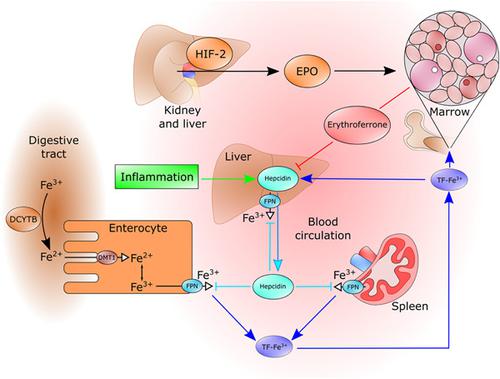当前位置:
X-MOL 学术
›
J. Cell. Physiol.
›
论文详情
Our official English website, www.x-mol.net, welcomes your
feedback! (Note: you will need to create a separate account there.)
Erythroferrone structure, function, and physiology: Iron homeostasis and beyond
Journal of Cellular Physiology ( IF 4.5 ) Pub Date : 2020-12-28 , DOI: 10.1002/jcp.30247 Daniel N Srole 1 , Tomas Ganz 2
Journal of Cellular Physiology ( IF 4.5 ) Pub Date : 2020-12-28 , DOI: 10.1002/jcp.30247 Daniel N Srole 1 , Tomas Ganz 2
Affiliation

|
Erythroferrone (ERFE) is the main erythroid regulator of hepcidin, the homeostatic hormone controlling plasma iron levels and total body iron. When the release of erythropoietin from the kidney stimulates the production of new red blood cells, it also increases the synthesis of ERFE in bone marrow erythroblasts. Increased ERFE then suppresses hepcidin synthesis, thereby mobilizing cellular iron stores for use in heme and hemoglobin synthesis. Recent mechanistic studies have shown that ERFE suppresses hepcidin transcription by inhibiting bone morphogenetic protein signaling in hepatocytes. In ineffective erythropoiesis, pathological overproduction of ERFE by an expanded population of erythroblasts suppresses hepcidin and causes iron overload, even in non‐transfused patients. ERFE may be a useful biomarker of ineffective erythropoiesis and an attractive target for treating its systemic effects.
中文翻译:

Erythroferrone 结构、功能和生理学:铁稳态及其他
Erythroferrone (ERFE) 是铁调素的主要红系调节剂,是控制血浆铁水平和全身铁的稳态激素。当肾脏释放促红细胞生成素刺激新红细胞的产生时,它也会增加骨髓成红细胞中 ERFE 的合成。增加的 ERFE 然后抑制铁调素合成,从而动员细胞铁储存用于血红素和血红蛋白合成。最近的机制研究表明,ERFE 通过抑制肝细胞中的骨形态发生蛋白信号传导来抑制铁调素转录。在无效的红细胞生成中,由扩大的成红细胞群体产生的 ERFE 病理性过量产生会抑制铁调素并导致铁过载,即使在未输血的患者中也是如此。
更新日期:2020-12-28
中文翻译:

Erythroferrone 结构、功能和生理学:铁稳态及其他
Erythroferrone (ERFE) 是铁调素的主要红系调节剂,是控制血浆铁水平和全身铁的稳态激素。当肾脏释放促红细胞生成素刺激新红细胞的产生时,它也会增加骨髓成红细胞中 ERFE 的合成。增加的 ERFE 然后抑制铁调素合成,从而动员细胞铁储存用于血红素和血红蛋白合成。最近的机制研究表明,ERFE 通过抑制肝细胞中的骨形态发生蛋白信号传导来抑制铁调素转录。在无效的红细胞生成中,由扩大的成红细胞群体产生的 ERFE 病理性过量产生会抑制铁调素并导致铁过载,即使在未输血的患者中也是如此。











































 京公网安备 11010802027423号
京公网安备 11010802027423号